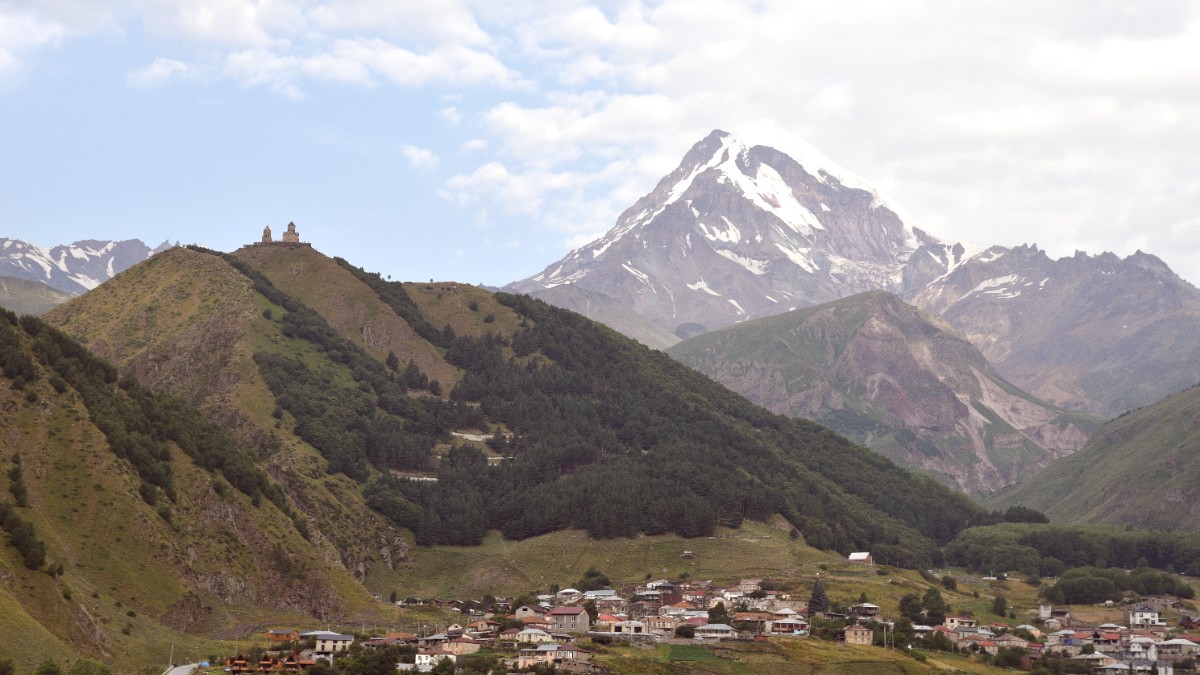
Georgia
Svanetian cuisine is a distinct and hearty regional variant of Georgian food, deeply rooted in the mountainous environment and agricultural traditions.
Its isolation led to unique dishes and the preservation of ancient cooking methods. The cuisine mirrors the need for calorie-rich sustenance in a harsh climate, with a strong focus on meat, dairy, and corn-based products. The unique Svanetian salt blend is a hallmark of the region, a complex aroma to many dishes.
If you are fortunate to be invited to a supra, a traditional Georgian feast, it is a profound cultural experience. Toasts are common and led by a Tamada (toastmaster). Taking small sips is acceptable. Engage in general conversation and enjoy the communal spirit.
Dishes are typically served family-style on large platters for sharing among the group. This encourages communal eating and sampling a variety of dishes.
Many dishes are for eating with your hands, especially bread and certain pies.
The most iconic Svanetian dish. This is a circular bread baked with spiced minced meat (beef, pork, or lamb) inside. The meat is seasoned with Svanetian salt, onions, and other herbs. It is hearty and flavorful.
Find it in almost all restaurants and guesthouses in Svaneti.
A stretchy, cheesy potato puree. Made with mashed potatoes, Sulguni cheese, and butter, it has an unique consistency. Often served as a side dish, but satisfying as a vegetarian main.
A common side dish everywhere.
A type of cornbread with Sulguni cheese baked inside. It is dense and savory, often served as a snack or a side dish.
A savory cornbread snack or side.
Chacha: Strong Georgian grape pomace brandy. Often homemade in villages, it is potent and frequently offered. Drink responsibly. Georgian Wine: Svaneti is not a wine-producing region, but quality Georgian wines from Kakheti and other regions are available in Mestia restaurants and shops.
Borjomi: Georgia’s famous naturally sparkling mineral water, with a distinct taste and supposed health benefits. Lagidze Water: Sweet, flavored soda drinks, often with unique flavors like tarragon, pear, or cream. A refreshing choice. Dried fruits and nuts: Locally grown fruits are often dried for consumption during colder months.
Several restaurants in Mestia serve traditional Svan and Georgian cuisine. Popular choices include Cafe Laila and Cafe Koshki, known for local dishes, reasonable prices, and sometimes live traditional music during high season. They offer a comfortable setting for a meal.
Local bakeries (furne) are the best option for budget meals like Khachapuri, Lobiani, or other pastries. Many guesthouses offer generous, home-cooked dinners as part of their half-board packages, excellent value. This is often the most authentic and satisfying dining experience.
Mestia has a small local market for fresh produce, local cheeses, Svanetian salt, and other local ingredients. A good place for snacks or picnic items. No large food halls. International cuisine is very limited; most establishments focus solely on Georgian and Svanetian dishes.
Possible, but can be challenging. Many Georgian dishes contain meat or dairy. Look for vegetarian options like various Khachapuri (cheese bread), Lobiani (bean-filled bread), different salads (tomato and cucumber salad with walnuts is common), Pkhali (vegetable paste dishes, often from spinach, beetroot, or beans with walnuts), Badrijani Nigvzit (fried eggplant rolls with walnut paste), and local cheeses. Always inquire about ingredients.
Gluten-free is difficult due to prevalence of bread.
More difficult. Georgian cuisine uses much dairy and eggs. Find options by specifying 'samarkhvo' (lean/fasting), which often implies vegan ingredients during Orthodox fasting periods, but always double-check. Focus on salads, Lobiani, and vegetable dishes without dairy.
Halal and Kosher food is not readily available.
Consider a translation app for communication.
Carry small notes explaining needs in Georgian.
Direct communication with guesthouse hosts is best.
Pre-packaged items for specific needs.
This is an unique and authentic dining concept in Svaneti. It features intimate, home-cooked meals, often shared with the guesthouse family and other guests, a profound sense of hospitality and cultural exchange.
Highly recommended for cultural immersion.
Fine dining establishments are very limited or non-existent in Svaneti. Some higher-end hotels in Mestia may feature a more refined dining experience with a wider menu, but do not expect Michelin-star quality or formal service.
Focus on authentic local flavors over formal dining.
During peak season, some restaurants in Mestia (e.g., Cafe Laila) feature live performances of traditional Georgian polyphonic singing and folk dances.
For dining options outside of guesthouses, popular choices for local dishes and reasonable prices include Cafe Laila and Cafe Koshki.
Some guesthouses may feature informal cooking classes for Svanetian dishes like Kubdari or Tashmijabi upon request.
Less common as organized tours, but many guesthouses source ingredients from their own gardens or local farms.
Local festivals like Lamproba (Candlemas in winter) or Kvirikoba (July 28th, a religious festival in Kala village) feature traditional food and communal feasting.
Many guesthouses prefer cash payments in Georgian Lari (GEL). Have small bills available, especially outside Mestia center.
Cash is king in Svaneti.
While English is spoken in tourist areas, a translation app or basic Georgian phrases are useful for direct communication with guesthouse owners regarding dietary needs or preferences.
A little Georgian goes a long way!
Experience true Svanetian flavors and hospitality with home-cooked meals.
Guesthouse half-board options often provide the best value for generous meals.
Dining with local families an unique opportunity for cultural exchange and connection.
While most dining is casual, remember that Georgian meals are social events. Be prepared for toasts and communal eating. Try to sample a wide range of dishes.